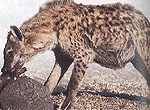SPOTTED HYENA

How to Recognize
Hyenas are quite common to see. There are two types Ė striped and spotted (we only saw the spotted hyena). Spotted hyenas look like large dogs but are actually more closely related to cats. They have sloping hindquarters, short black tails, and a distinctive walk. They are rusty or tan in color with dark spots, and they have round faces and ears and a broad black muzzle.
Their powerful jaws are their main weapon and tool, as their teeth can shear through bone and thick hides.
Females are larger and dominant to the male because of their high levels of testosterone. Females dominate males at kills, they determine the clan structure, protect communal dens, and initiate hunts and territorial disputes. They even have male physical characteristics, one being an erectile clitoris than can elongate like a penis.
Habitat
Hyenas can tolerate a wide variety of habitats with the exception of dense forests. They can be found in open savannah, thorn scrub, and montane grass where there is abundant prey. They like dens in rocky country.
Behavior
Nocturnal but also active at dusk. They are also diurnal in many parks. They cool off by lying in puddles. If they spot vultures honing in on a kill, they will quickly follow. The female-dominated, competitive clans are highly social (especially before setting out to hunt) and usually live in extended family groups sometimes numbering 100 animals. Males disperse to other clans after the age of two.
Breeding
Cubs are born in dens after a four month gestation. They suckle for eight months and are weaned for twelve to sixteen months in communal dens with higher-ranking offspring being weaned the fastest. Males mate through the femaleís enlarged clitoris, and the cubs are even born through it. Cubs are born with fully formed front teeth and, if female, the first-born tries to kill the second if itís also female. Vicious!
Feeding
Hyenas are carnivorous, hunting large and small mammals. They like wildebeests, Thomsonís gazelles, and the young of other antelopes. They will also eat dead, putrefying, or dry flesh and even human refuse. They can intimidate cheetahs, leopards, and lions.
Hyenas have been portrayed as cowardly scavengers (they will steal kills when an opportunity arrives), but they are actually highly efficient predators. In fact, research has shown that many kills previously attributed to lions are actually spotted hyena kills stolen by lions! They can reach speeds up to 37 mph, and a pack of hyenas can easily take down adult wildebeests and zebras.
The hunt starts with one or two hyenas wearing down a victim for hours by nipping at its heals. Eventually the prey is stopped by the hyenas biting its legs and belly, and finally clamping down with their jaws on the victimís genitals and tail. The chase and kill attracts other clan members who start fighting with each other. This squabbling attracts lions and rival hyena clans, and battles break out that can result in deaths from both groups.
TOP OF PAGE
Copyright © 2002, Dawn M. Dalton.
All rights reserved.
**LINKS**
WHERE?
WHY?
ITINERARY
PLAN YOUR TRIP
GETTING THERE
LONDON
KENYA
UGANDA
SAFETY
ITEMS BOUGHT
STAYING HEALTHY
COMMENTS
HOME
BHS HOME
---Animal Facts--
Baboon
Buffalo
Cheetah
Chimpanzee
Crocodile
Eland
Elephant
Gazelle
Giant Forest Hog
Giraffe
Gorilla
Hippopotamus
Hyena
Hyrax
Impala
Jackal
Lion
Mongoose
Monkey
Ostrich
Rhinoceros
Topi
Uganda Kob
Warthog
Waterbuck
Wildebeest
Zebra